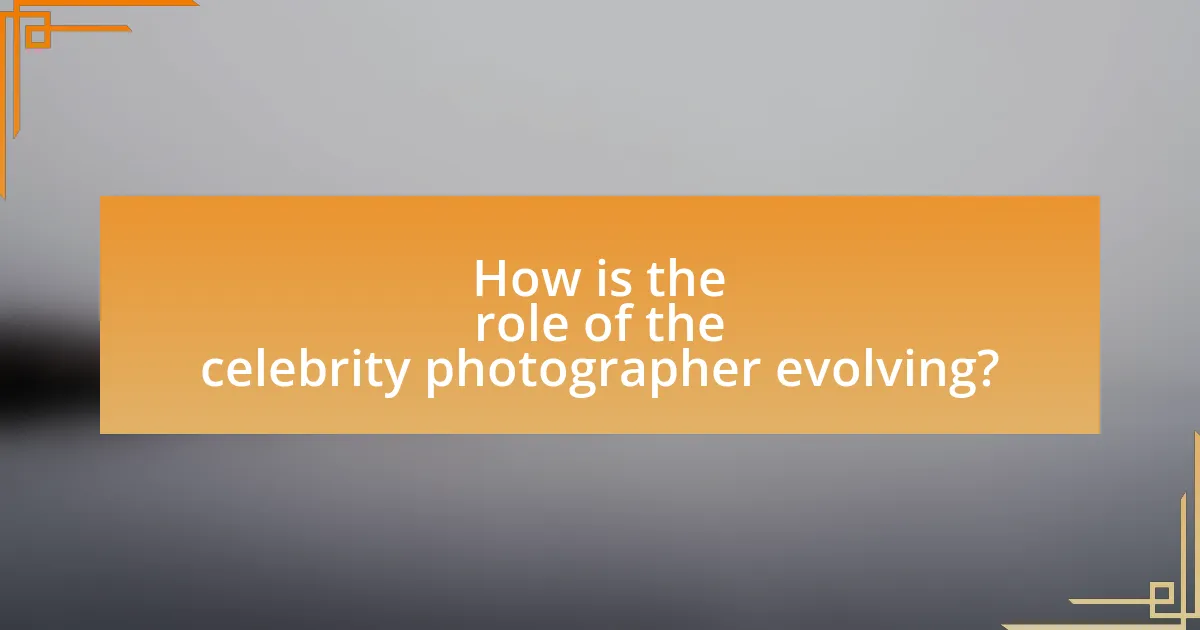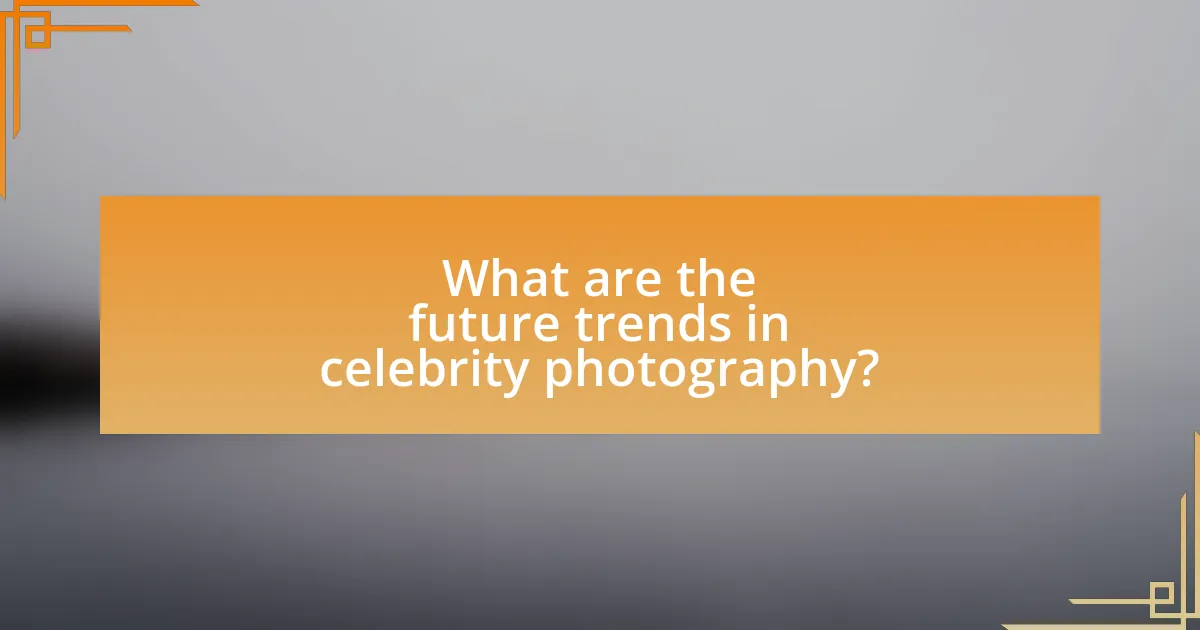The article examines the evolving landscape of celebrity photography in a digital-first world, highlighting the impact of social media and user-generated content on traditional photography practices. It discusses how digital technology has transformed the industry, emphasizing the importance of immediacy and authenticity in celebrity imagery. Key technological advancements, such as high-resolution cameras and AI tools, are explored, along with the challenges posed by content saturation and ethical considerations. The article also addresses the changing role of photographers, the necessity for new skills, and emerging trends that shape audience engagement and the future of celebrity photography.

What is the Future of Celebrity Photography in a Digital-First World?
The future of celebrity photography in a digital-first world will increasingly rely on social media platforms and user-generated content. As celebrities engage directly with their audiences through platforms like Instagram and TikTok, traditional photography methods are being supplemented by real-time, candid images shared by fans and influencers. This shift is evidenced by the rise of platforms where immediacy and authenticity are prioritized, leading to a decline in demand for staged, professional photoshoots. According to a 2022 survey by the Pew Research Center, 72% of adults in the U.S. use social media, indicating a significant audience for celebrity content that is often captured and disseminated by everyday users rather than professional photographers.
How has digital technology transformed celebrity photography?
Digital technology has transformed celebrity photography by enabling instant access, high-quality images, and widespread sharing across platforms. The advent of digital cameras and smartphones has allowed photographers to capture and disseminate images rapidly, leading to a significant increase in the volume of celebrity photos available online. For instance, the transition from film to digital photography has improved image quality and editing capabilities, allowing for more creative and polished representations of celebrities. Additionally, social media platforms like Instagram and Twitter have democratized celebrity photography, allowing fans and amateur photographers to share their own images, which has shifted the power dynamics in how celebrity images are produced and consumed. This transformation is evidenced by the fact that over 1 billion photos are shared daily on Instagram, highlighting the platform’s role in celebrity culture.
What are the key technological advancements influencing celebrity photography?
Key technological advancements influencing celebrity photography include high-resolution cameras, advanced editing software, and social media platforms. High-resolution cameras, such as those with 100 megapixels or more, allow photographers to capture intricate details, enhancing the quality of images significantly. Advanced editing software, like Adobe Photoshop and Lightroom, provides tools for retouching and enhancing photos, enabling photographers to create polished final products. Social media platforms, particularly Instagram, have transformed how celebrity photography is shared and consumed, allowing for real-time engagement and broader audience reach. These advancements collectively shape the landscape of celebrity photography, making it more dynamic and accessible.
How do social media platforms impact the way celebrity photography is consumed?
Social media platforms significantly alter the consumption of celebrity photography by enabling direct access and interaction between fans and celebrities. This shift allows users to view real-time images and updates, fostering a sense of intimacy and immediacy that traditional media cannot replicate. For instance, platforms like Instagram and Twitter have become primary sources for celebrity images, with over 1 billion users on Instagram sharing and engaging with visual content daily. This democratization of celebrity photography means that fans can curate their experiences and engage with content that resonates with them, leading to a more personalized consumption pattern. Additionally, the prevalence of user-generated content and the viral nature of social media amplify the reach and impact of celebrity photography, making it more accessible and influential in shaping public perception.
What challenges does celebrity photography face in a digital-first environment?
Celebrity photography faces significant challenges in a digital-first environment, primarily due to the oversaturation of content and the rapid pace of social media. The abundance of images and videos shared online makes it difficult for photographers to capture unique moments that stand out. Additionally, the immediacy of digital platforms often pressures photographers to prioritize speed over quality, leading to a decline in the artistic value of their work. Furthermore, the rise of user-generated content means that fans and amateurs can easily replicate professional shots, diminishing the exclusivity and market value of celebrity photography. This shift has been documented in studies showing that professional photographers are increasingly competing with non-professionals who have access to similar technology and platforms.
How does the saturation of content affect the quality of celebrity photography?
The saturation of content negatively affects the quality of celebrity photography by overwhelming audiences and diluting the impact of individual images. As the volume of celebrity photographs increases, the uniqueness and artistic value of each image can diminish, leading to a homogenization of styles and themes. This phenomenon is supported by the fact that, according to a study by the Pew Research Center, 72% of adults feel overwhelmed by the amount of information available online, which can result in decreased engagement with celebrity photography. Consequently, photographers may struggle to capture attention and convey meaningful narratives, ultimately lowering the overall quality of their work.
What ethical considerations arise in digital celebrity photography?
Ethical considerations in digital celebrity photography include privacy invasion, consent, and the potential for misinformation. Privacy invasion occurs when photographers capture images of celebrities in private settings without their knowledge, violating personal boundaries. Consent is crucial, as many celebrities may not agree to the use of their images for commercial purposes, raising issues of exploitation. Additionally, the ease of digital manipulation can lead to misinformation, where altered images misrepresent a celebrity’s appearance or actions, impacting public perception. These factors highlight the need for ethical guidelines in the practice of digital celebrity photography to protect individuals’ rights and maintain integrity in representation.

How is the role of the celebrity photographer evolving?
The role of the celebrity photographer is evolving to encompass a broader range of skills, including digital content creation and social media engagement. Traditionally focused on capturing high-profile images for magazines and events, celebrity photographers now also produce multimedia content tailored for platforms like Instagram and TikTok, where immediacy and relatability are key. This shift is driven by the increasing demand for authentic and behind-the-scenes glimpses into celebrities’ lives, as evidenced by the rise of influencer culture and the decline of print media. Consequently, photographers must adapt by mastering new technologies and understanding digital marketing strategies to remain relevant in a rapidly changing landscape.
What new skills are required for photographers in the digital age?
Photographers in the digital age require skills in digital editing, social media marketing, and data analytics. Digital editing skills are essential for enhancing images using software like Adobe Photoshop and Lightroom, which are industry standards. Social media marketing skills enable photographers to effectively promote their work and engage with audiences on platforms like Instagram and TikTok, where visual content thrives. Data analytics skills help photographers understand audience preferences and trends, allowing them to tailor their work for maximum impact. These skills are increasingly vital as the photography landscape evolves with technology and consumer behavior.
How important is social media proficiency for modern celebrity photographers?
Social media proficiency is crucial for modern celebrity photographers. In today’s digital-first world, platforms like Instagram and Twitter serve as primary channels for showcasing work, engaging with audiences, and building a personal brand. According to a 2021 survey by the American Society of Media Photographers, 78% of photographers reported that social media significantly increased their visibility and client inquiries. This demonstrates that effective use of social media not only enhances a photographer’s reach but also directly impacts their career opportunities and success in the competitive field of celebrity photography.
What role does personal branding play for photographers today?
Personal branding is crucial for photographers today as it differentiates them in a saturated market. In the digital-first world, where social media and online portfolios dominate, a strong personal brand helps photographers establish their unique style and connect with their target audience. According to a survey by the Professional Photographers of America, 70% of photographers reported that their personal brand significantly influenced their client acquisition and retention. This highlights the importance of a well-defined personal brand in attracting clients and building a loyal customer base.
How are celebrity photographers adapting to changing audience expectations?
Celebrity photographers are adapting to changing audience expectations by embracing social media platforms and prioritizing authenticity in their work. As audiences increasingly seek relatable and candid moments over traditional posed images, photographers are shifting their focus to capture behind-the-scenes content and personal stories that resonate with fans. This shift is evidenced by the rise of platforms like Instagram, where spontaneous and unfiltered images garner higher engagement rates, demonstrating a clear preference for genuine interactions over curated perfection. Additionally, many photographers are collaborating with celebrities to create content that aligns with their personal brands, further enhancing the connection with audiences.
What trends are emerging in audience engagement with celebrity photography?
Emerging trends in audience engagement with celebrity photography include increased interactivity through social media platforms, where fans actively participate in content creation and sharing. This shift is evidenced by the rise of user-generated content, where audiences remix or reinterpret celebrity images, fostering a sense of community and connection. Additionally, the use of augmented reality (AR) filters in apps like Instagram and Snapchat allows users to engage with celebrity imagery in immersive ways, enhancing their experience. Data from a 2022 survey by Statista indicates that 70% of users engage more with content that allows for personalization, highlighting the importance of interactive elements in celebrity photography.
How do photographers balance artistic vision with audience preferences?
Photographers balance artistic vision with audience preferences by integrating personal creativity with market trends. They often analyze audience engagement metrics, such as likes and shares on social media platforms, to understand what resonates with viewers while maintaining their unique style. For instance, a study by the Pew Research Center indicates that 72% of social media users engage with visual content, prompting photographers to adapt their work to align with popular aesthetics without compromising their artistic integrity. This dual approach allows photographers to create compelling images that satisfy both their creative impulses and the expectations of their audience.

What are the future trends in celebrity photography?
Future trends in celebrity photography include the rise of AI-generated images, increased use of social media platforms for real-time engagement, and a shift towards more authentic, candid styles that reflect personal branding. AI technology is enabling photographers to create hyper-realistic images and manipulate visuals in ways that were previously impossible, enhancing creativity and efficiency. Social media platforms like Instagram and TikTok are becoming primary venues for celebrity interactions, leading to a demand for spontaneous and relatable content that resonates with audiences. Additionally, the trend towards authenticity is pushing photographers to capture celebrities in more natural settings, moving away from traditional posed shots to images that tell a story and connect on a personal level. These trends are supported by the growing importance of digital presence in celebrity culture, as evidenced by the increasing follower counts and engagement rates on social media platforms.
How will artificial intelligence shape the future of celebrity photography?
Artificial intelligence will significantly transform celebrity photography by enhancing image processing, automating editing tasks, and personalizing content delivery. AI algorithms can analyze vast amounts of data to identify trends in celebrity imagery, allowing photographers to create more appealing and relevant visuals. For instance, AI-driven tools can automatically retouch images, adjust lighting, and even generate realistic backgrounds, streamlining the workflow for photographers. Additionally, AI can personalize the viewing experience by curating content based on user preferences, which is supported by the increasing use of machine learning in social media platforms to tailor feeds. This integration of AI not only improves efficiency but also elevates the quality and relevance of celebrity photography in a digital-first world.
What potential applications of AI can enhance celebrity photography?
AI can enhance celebrity photography through applications such as automated image editing, facial recognition, and personalized content generation. Automated image editing tools, powered by AI algorithms, can significantly reduce the time required for retouching and enhancing photos, allowing photographers to focus on creativity. Facial recognition technology can streamline the process of identifying celebrities in large crowds or events, improving the efficiency of capturing candid moments. Additionally, AI can generate personalized content by analyzing audience preferences and trends, enabling tailored marketing strategies that resonate with fans. These applications demonstrate the transformative potential of AI in optimizing the workflow and output quality in celebrity photography.
How might AI change the role of photographers in the industry?
AI is likely to transform the role of photographers in the industry by automating routine tasks, enhancing image editing, and enabling new creative possibilities. Photographers will increasingly rely on AI tools for functions such as image sorting, tagging, and basic editing, which can significantly reduce the time spent on these tasks. For instance, AI algorithms can analyze thousands of images to identify the best shots based on composition and lighting, allowing photographers to focus more on creative aspects rather than technical details. Additionally, AI-driven software can assist in advanced editing processes, such as retouching and color correction, making high-quality results more accessible. This shift may lead to a redefinition of the photographer’s role, emphasizing creativity and storytelling over technical execution, as AI handles more of the operational workload.
What innovations are on the horizon for celebrity photography?
Innovations on the horizon for celebrity photography include the integration of artificial intelligence (AI) for enhanced image processing and real-time editing. AI algorithms can analyze and optimize images instantly, allowing photographers to produce high-quality content more efficiently. Additionally, advancements in augmented reality (AR) and virtual reality (VR) are set to transform how celebrity interactions are captured, enabling immersive experiences for fans. For instance, AR can overlay digital elements onto real-world images, creating unique visual narratives. Furthermore, the rise of drone technology is facilitating aerial photography, offering new perspectives and dynamic shots that were previously difficult to achieve. These innovations are supported by ongoing developments in camera technology, such as higher resolution sensors and improved low-light performance, which enhance the overall quality of celebrity photography.
How are virtual reality and augmented reality influencing celebrity photography?
Virtual reality (VR) and augmented reality (AR) are significantly transforming celebrity photography by creating immersive experiences and interactive content. These technologies allow photographers to capture and present celebrities in dynamic environments, enhancing visual storytelling. For instance, AR applications enable fans to interact with 3D models of celebrities or experience virtual meet-and-greets, increasing engagement and emotional connection. Additionally, VR can transport users to exclusive events or behind-the-scenes moments, offering a unique perspective that traditional photography cannot provide. This shift is supported by the growing adoption of AR and VR in marketing campaigns, with brands leveraging these technologies to create memorable experiences that resonate with audiences, as seen in campaigns by major companies like Nike and Gucci.
What new formats are emerging for celebrity photography in a digital-first world?
New formats emerging for celebrity photography in a digital-first world include social media-driven content, augmented reality (AR) experiences, and interactive video formats. Social media platforms like Instagram and TikTok have transformed celebrity photography by prioritizing candid, behind-the-scenes images and short video clips that engage audiences in real-time. Augmented reality allows fans to interact with celebrity images in immersive ways, enhancing the viewing experience. Additionally, interactive video formats, such as 360-degree videos, enable viewers to explore celebrity environments dynamically, creating a more engaging and personalized experience. These trends reflect the shift towards more immediate and participatory forms of visual storytelling in the digital landscape.
What practical tips can photographers follow to thrive in the digital-first landscape?
Photographers can thrive in the digital-first landscape by embracing social media platforms for showcasing their work and engaging with audiences. Utilizing platforms like Instagram and TikTok allows photographers to reach a broader audience, as these platforms have millions of active users daily. Additionally, photographers should invest in high-quality editing software to enhance their images, as studies show that well-edited photos receive significantly more engagement online. Networking with other professionals in the industry through online forums and virtual events can also provide valuable opportunities for collaboration and exposure. Lastly, staying updated with the latest trends in photography and technology is crucial, as the digital landscape is constantly evolving, and adapting to these changes can lead to greater success.



